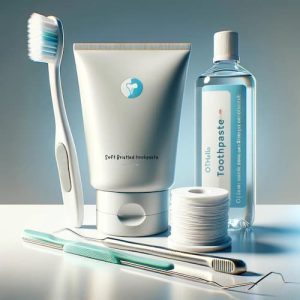When you’re on a journey to a straighter smile with braces, think of oral hygiene as your road map. It’s the guide that ensures you reach your destination with a healthy, dazzling smile. And for those navigating this path in Manchester, let’s make sure you’re equipped with the best oral hygiene tips to keep your braces in top shape. Your braces are doing the hard work of aligning your teeth, but they also create tiny hideouts for food particles and plaque, which can lead to issues if not addressed properly. So, buckle up and let’s dive into how you can maintain stellar oral health while sporting braces.
Key Takeaways
- Use a soft-bristled toothbrush and fluoride toothpaste to brush your teeth with braces.
- Floss daily using a floss threader or orthodontic floss to navigate around braces.
- Avoid sticky, hard, or crunchy foods that can damage braces and hinder oral hygiene.
- Rinse with an antiseptic or fluoride mouthwash to reduce plaque and strengthen teeth.
- Regular orthodontic check-ups are crucial for adjusting braces and assessing oral hygiene.

Why Braces Need Special Care
Braces are not just a cosmetic enhancement; they’re a commitment to a healthier mouth. But, they come with a responsibility. The brackets and wires are great at straightening teeth, but they also create nooks and crannies where food and plaque can easily hide. Without proper care, these areas can become breeding grounds for bacteria, leading to cavities, gum disease, and even bad breath. That’s why it’s crucial to step up your oral hygiene game when you have braces.
Understanding the Risks of Poor Oral Hygiene with Braces
Imagine braces as a miniature obstacle course for your toothbrush and floss. Food particles that get trapped can lead to plaque—a sticky, colourless film of bacteria. If plaque isn’t removed, it can harden into tartar, which is much tougher to get rid of. And if bacteria run rampant, they can irritate and inflame your gums, causing gingivitis. Besides that, lingering food and plaque can cause demineralization, leaving unsightly white spots on your teeth after braces are removed.
The Role of Braces in Oral Health
Braces do more than straighten teeth—they can also correct bite issues and improve overall oral function. But for braces to do their job effectively, they need to be taken care of. Good oral hygiene ensures that braces can work unimpeded by dental complications. Plus, when your braces come off, you want to reveal not just straight teeth, but a healthy, white smile free from cavities and stains.
Brushing Techniques for Braces
Brushing with braces isn’t just about moving the toothbrush around your mouth. It’s about being thorough and gentle at the same time. You’ll want to brush after every meal to ensure that no food particles remain trapped in your braces. But don’t just scrub away—braces require a bit of finesse to clean effectively.
Selecting the Right Toothbrush
Your toothbrush is your primary weapon against plaque, so choose wisely. A soft-bristled toothbrush is a must as it’s gentle on your gums and won’t damage the brackets or wires. Some may find an electric toothbrush with a specialized orthodontic head particularly effective, as it can navigate around braces with ease.
Step-By-Step Brushing Guide for Optimal Cleaning
Now, let’s break down the brushing process:
- Start by rinsing your mouth to dislodge any loose food particles.
- Apply a pea-sized amount of fluoride toothpaste to your soft-bristled toothbrush.
- Hold the toothbrush at a 45-degree angle to your gums, and gently brush in a circular motion. Make sure to clean each tooth at the gum line as well as above and below the brackets.
- Brush all surfaces of the teeth: the outsides, insides, and chewing surfaces, as well as the brackets and wires of your braces.
- Take your time—spend at least two minutes brushing to ensure a thorough clean.
Most importantly, remember to replace your toothbrush every three months or sooner if the bristles become frayed. A worn toothbrush won’t do your braces any favours.
Rinsing your mouth isn’t just about that refreshing feeling; it’s a crucial step in your oral hygiene routine, especially when you have braces. After brushing and flossing, rinsing can help remove any lingering particles and bacteria, and provide an additional layer of protection for your teeth and gums.
Rinsing: An Additional Layer of Protection
Antiseptic vs. Fluoride Rinses
When it comes to mouthwashes, you have options, and each serves a different purpose. Antiseptic rinses are great for killing bacteria and keeping bad breath at bay. On the other hand, fluoride rinses help strengthen the enamel and protect against cavities. If you’re not sure which to choose, consult with your orthodontist, as they can recommend the best option based on your specific needs.
Timing Your Rinse for Maximum Effect
Timing is everything. For the best results, use a mouthwash after brushing and flossing. Swish it around for 30 seconds to a minute to give it enough time to work its magic. And remember, don’t rinse your mouth with water immediately after, as this can wash away the beneficial ingredients.
Eating Habits That Support Braces Hygiene
 Foods to Avoid with Braces
Foods to Avoid with Braces
Some foods are braces’ worst enemies. They can damage the wires, loosen brackets, or get stuck and lead to plaque build-up. To keep your braces and teeth in top condition, steer clear of:
- Sticky candies like caramel or gummy bears
- Hard foods like nuts and hard candies
- Crunchy snacks like popcorn and ice
- Chewy foods like bagels and liquorice
It’s not just about avoiding damage; it’s also about making cleaning your braces easier and preventing decay.
Nutritional Choices that Promote Oral Health
Besides avoiding the no-nos, focusing on a balanced diet is key. Foods rich in calcium and phosphorus, such as dairy products and leafy greens, can help strengthen your teeth. Crunchy fruits and vegetables, like apples and carrots, can act like natural toothbrushes, helping to clean your teeth as you chew.
Let’s not forget, regular orthodontic visits are the checkpoints along your journey with braces. They’re essential for adjusting your braces and making sure your teeth are moving correctly. But they also play a vital role in maintaining your oral hygiene.
Regular Orthodontic Visits: Keeping on Track
How Orthodontists Assess and Enhance Oral Hygiene
At each visit, your orthodontist will check not just the progress of your braces, but also the cleanliness of your teeth and gums. They can spot any potential issues early on and provide tips or products to help you improve your oral hygiene routine.
Scheduling and Preparing for Appointments
To stay on track, you’ll typically need to visit your orthodontist every 4-6 weeks. Make the most of these appointments by coming prepared with questions or concerns about your oral hygiene. And always follow through with the advice given, as it’s tailored to keep your teeth healthy and move you closer to your perfect smile.
Discovering the Tools of the Trade
Investing in Orthodontic Hygiene Products
There’s an arsenal of tools designed specifically for those with braces. Water flossers can be a game-changer, using a stream of water to clean around brackets and between teeth. Orthodontic flossers, meanwhile, are designed to thread floss through the wires easily. And let’s not forget orthodontic toothbrushes, with bristles cut out to fit around your braces. Investing in these tools can make maintaining your oral hygiene much easier and more effective.
Handling Emergencies and Orthodontic Discomfort
Even with the best care, emergencies can happen. It’s important to know how to respond when they do. Whether it’s a broken wire or a loose bracket, acting quickly and appropriately can make all the difference in your comfort and the success of your treatment.
What to Do When Braces Need Immediate Care
 If you experience a true orthodontic emergency, such as severe pain that can’t be managed with over-the-counter pain relievers or a broken wire that’s causing injury to your cheeks or gums, contact your orthodontist immediately. They can provide guidance on what to do and may schedule an emergency appointment to address the issue.
If you experience a true orthodontic emergency, such as severe pain that can’t be managed with over-the-counter pain relievers or a broken wire that’s causing injury to your cheeks or gums, contact your orthodontist immediately. They can provide guidance on what to do and may schedule an emergency appointment to address the issue.
For less severe issues, such as a loose bracket, cover any sharp edges with dental wax and call your orthodontist to schedule a repair. It’s always better to address these issues sooner rather than later to avoid any disruptions in your treatment plan.
Home Remedies for Common Braces Issues
Minor discomfort and irritations are common when you have braces. Here are some home remedies to help you cope:
- Rinse your mouth with warm salt water to soothe sore gums.
- Apply a cold compress to your cheeks to reduce swelling and discomfort.
- Use orthodontic wax to cover any poking wires or brackets that are irritating your mouth.
- Take over-the-counter pain relievers as needed to manage discomfort.
FAQs
Having braces often comes with a lot of questions. Let’s address some of the most common ones to help you stay informed and confident in your oral hygiene routine.
How often should I brush my teeth if I have braces?
With braces, it’s best to brush your teeth after every meal and snack, if possible. At the very least, aim to brush twice a day and floss once daily. This helps prevent dental wax food particles from lingering and causing plaque build-up around your braces.
Can dental wax help with braces discomfort?
Yes, absolutely. Dental wax is a soft, malleable material that can be applied to the parts of your braces that are causing irritation. It forms a smooth barrier between your braces and the inside of your mouth, which can provide relief from poking wires or brackets.
Is it normal for teeth to feel loose during orthodontic treatment?
Feeling a bit of looseness in your teeth is perfectly normal when you have braces. This sensation is a sign that your teeth are moving into their new positions. However, if the looseness is accompanied by severe pain or doesn’t improve, it’s important to consult your orthodontist.
How do I know if my braces are clean enough?
A good indicator is if you’re following the recommended brushing and flossing routine and attending your regular orthodontic check-ups. Your orthodontist can help assess the cleanliness of your braces. If there’s room for improvement, they’ll guide you on how to step up your cleaning game.
What should I do if I break a bracket or wire?
If a bracket breaks or a wire snaps, don’t panic. Cover any sharp or protruding edges with dental wax to protect your mouth. Then, get in touch with your orthodontist as soon as possible to schedule a repair. It’s important to address broken components quickly to ensure your treatment stays on track.
This site has been developed by West Pro Media Services. LinkedIn
